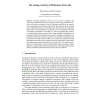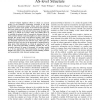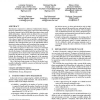INFOCOM
2012
IEEE
12 years 3 months ago
2012
IEEE
—Thorup-Zwick (TZ) compact routing guarantees sublinear state growth with the size of the network by routing via landmarks and incurring some path stretch. It uses a pseudo-rando...
PAM
2012
Springer
12 years 8 months ago
2012
Springer
This paper studies the AS-level re-wiring dynamics (changes in the connectivity) of malicious networks. Anecdotal evidence suggests that some malicious ASes that are primarily invo...
TON
2010
13 years 11 months ago
2010
— Despite significant efforts to obtain an accurate picture of the Internet’s connectivity structure at the level of individual autonomous systems (ASes), much has remained un...
INFOCOM
2010
IEEE
13 years 11 months ago
2010
IEEE
Abstract—When forwarding packets in the Internet, Autonomous Systems (ASes) frequently choose the shortest path in their network to the next-hop AS in the BGP path, a strategy kn...
INFOCOM
2010
IEEE
13 years 11 months ago
2010
IEEE
—While many attacks are distributed across botnets, investigators and network operators have recently targeted malicious networks through high profile autonomous system (AS) de-...
CCR
2004
14 years 18 days ago
2004
An important factor in the robustness of the interdomain routing system is whether the routers in autonomous systems (ASes) filter routes for "bogon" address space--i.e....
COMCOM
2007
14 years 22 days ago
2007
This paper addresses the issue of provisioning end-to-end bandwidth guarantees across multiple Autonomous Systems (ASes). We first review a cascaded model for negotiating and est...
BMCBI
2006
14 years 23 days ago
2006
Background: The evolution of alternatively spliced exons (ASEs) is of primary interest because these exons are suggested to be a major source of functional diversity of proteins. ...
CN
2008
14 years 25 days ago
2008
The connectivity of the Internet crucially depends on the relationships between thousands of Autonomous Systems (ASes) that exchange routing information using the Border Gateway P...
SIGCOMM
2010
ACM
14 years 28 days ago
2010
ACM
The Internet is organized as a collection of administrative domains, known as Autonomous Systems (ASes). These ASes interact through the Border Gateway Protocol (BGP) that allows ...



